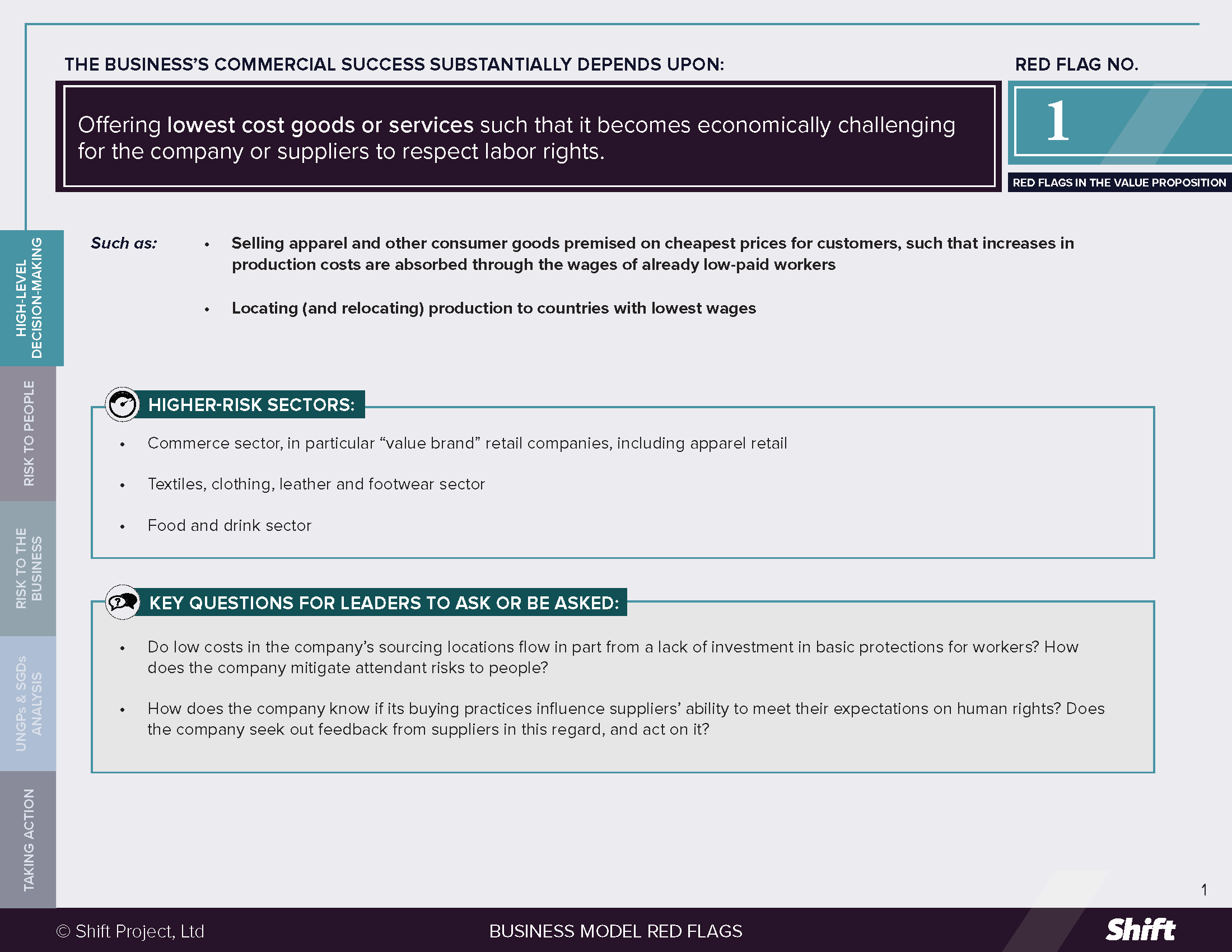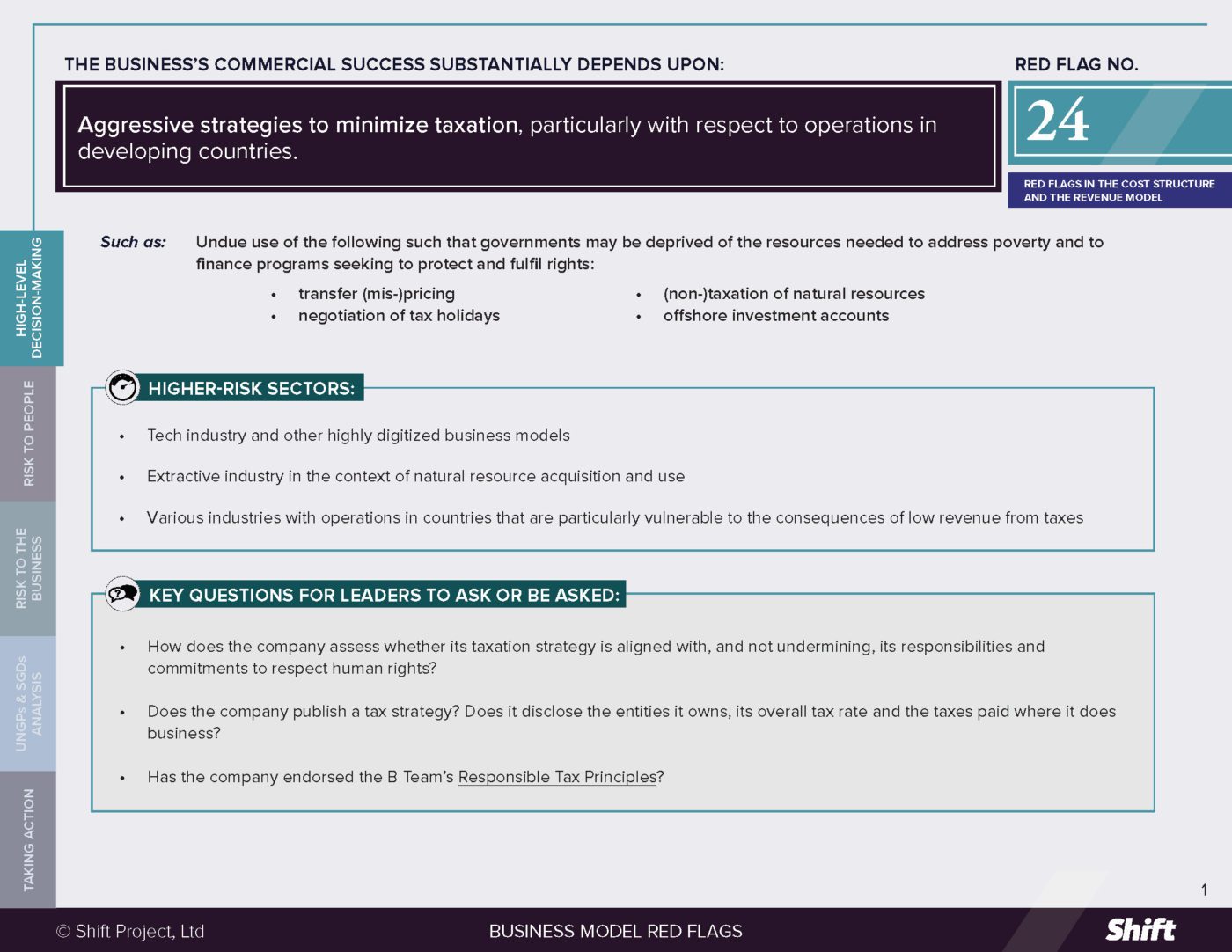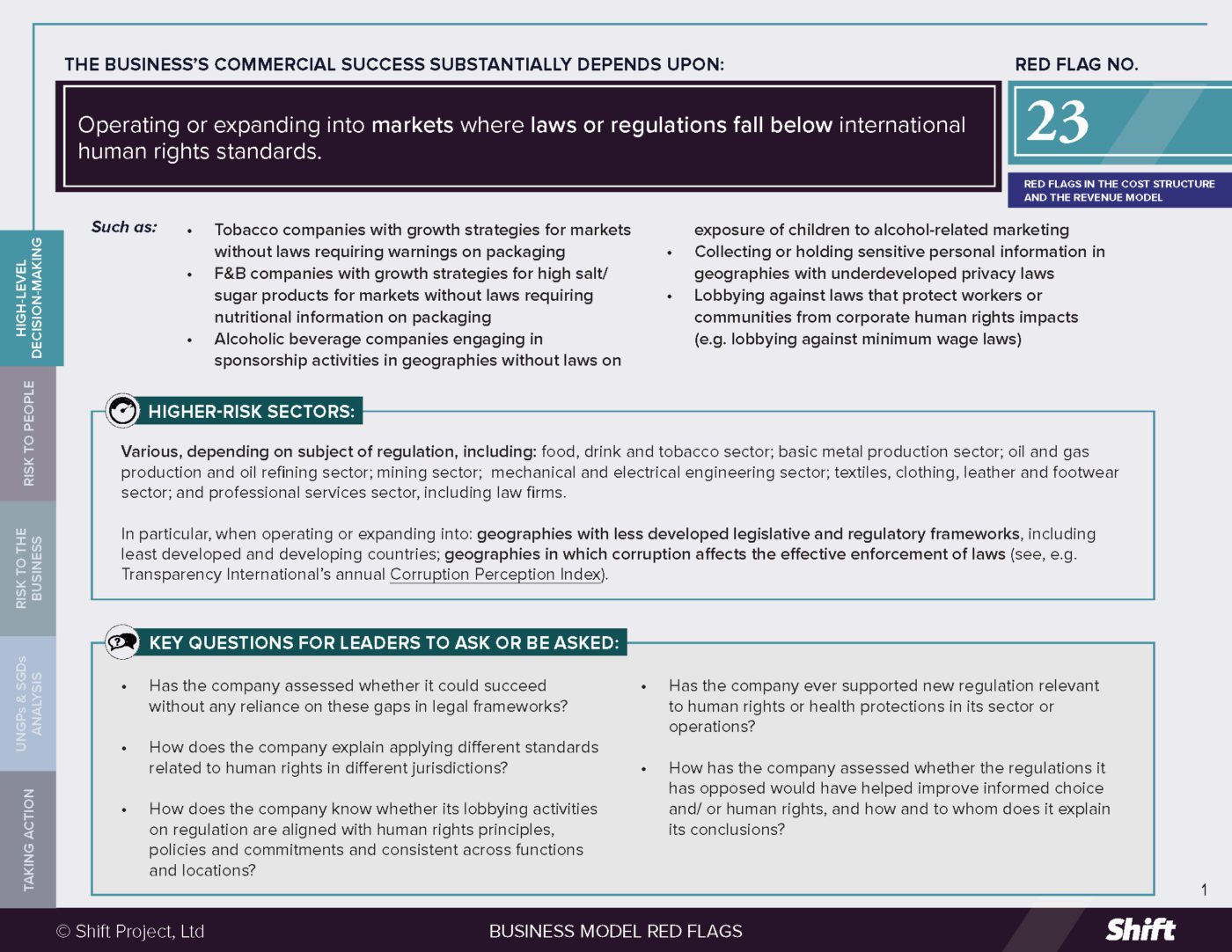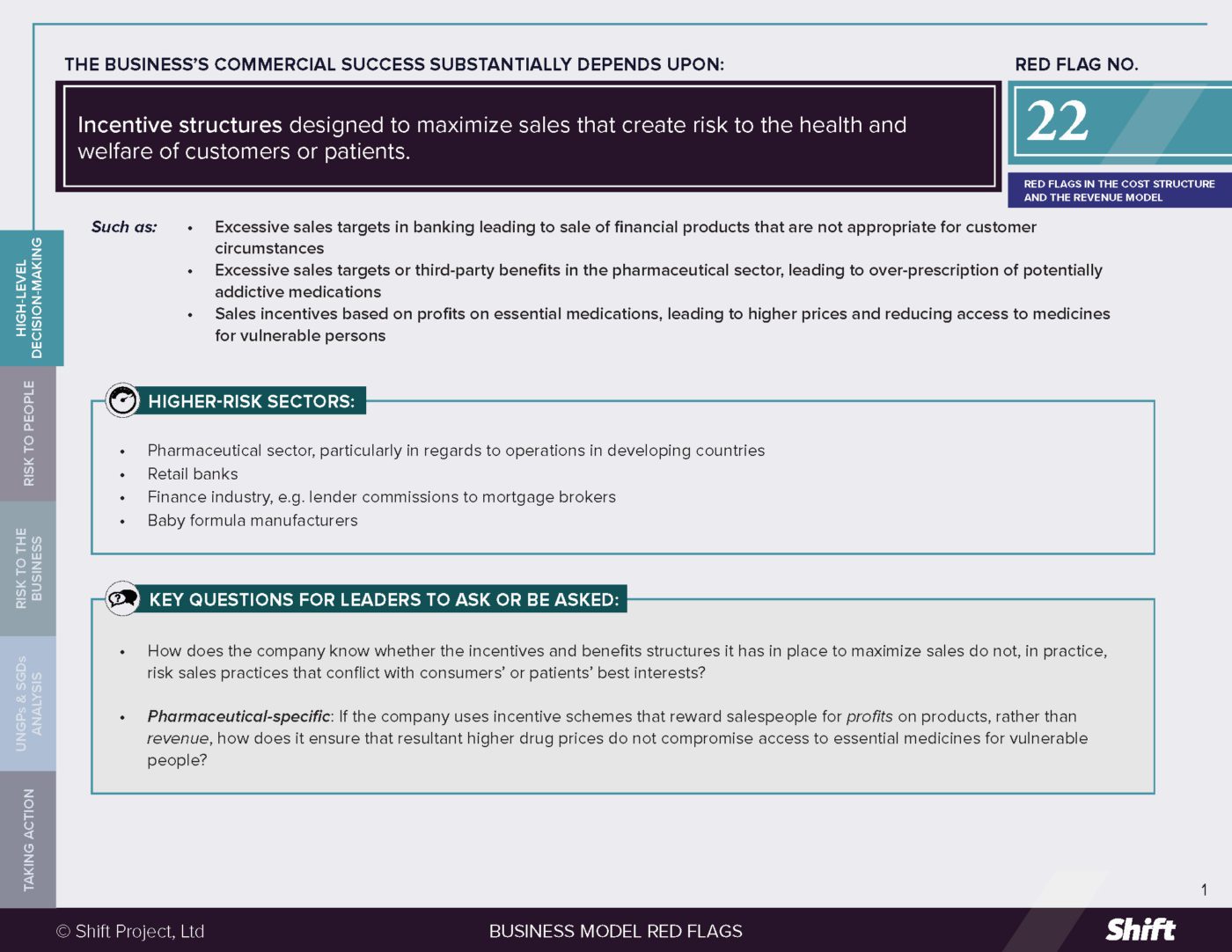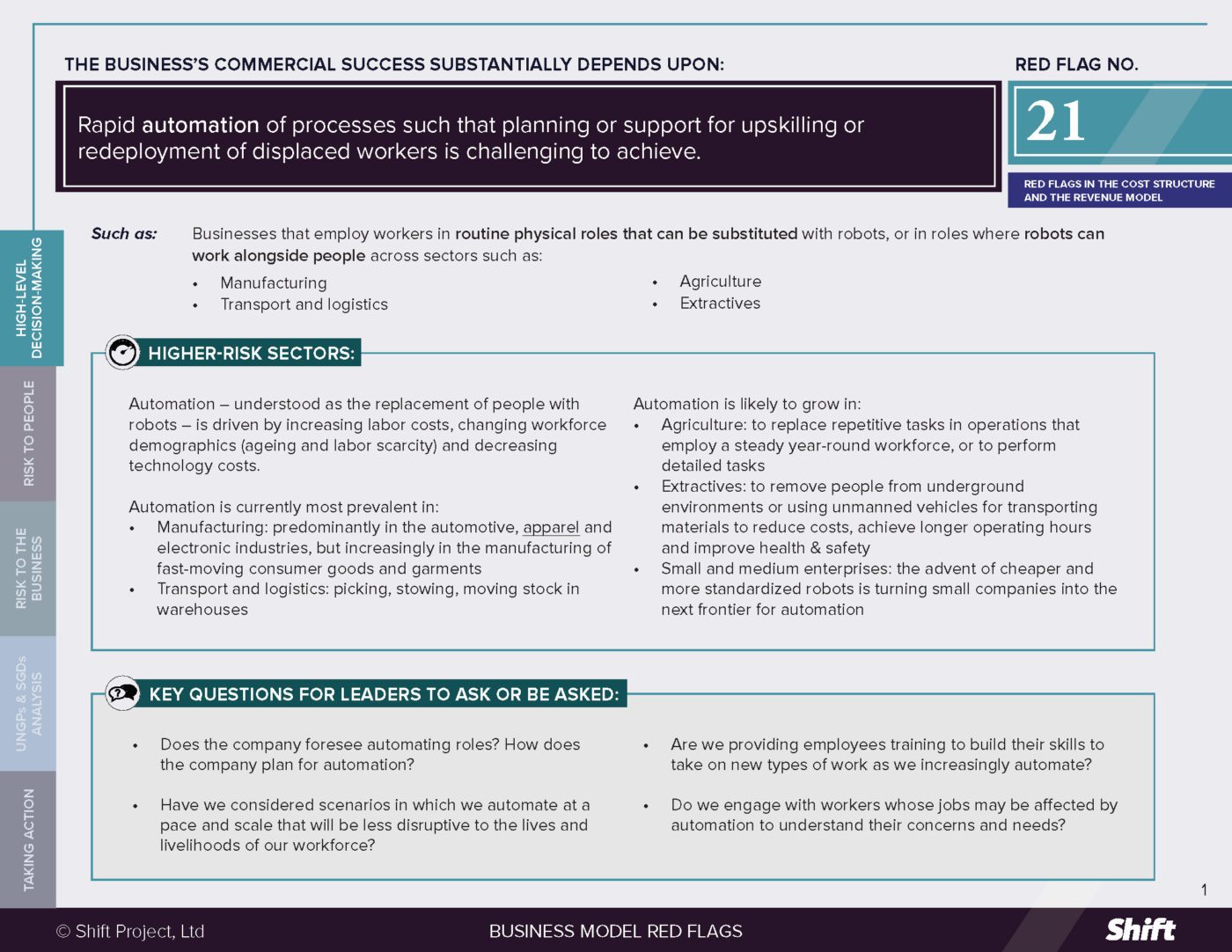RED FLAG # 1
The business’s commercial success substantially depends upon offering lowest cost goods or services such that it becomes economically challenging for the company or suppliers to respect labor rights.
FOR EXAMPLE
- Selling apparel and other consumer goods premised on cheapest prices for customers, such that increases in production costs are absorbed through the wages of already low-paid workers
- Locating (and relocating) production to countries with lowest wages
HIGHER-RISK SECTORS
- Commerce sector, in particular “value brand” retail companies, including apparel retail
- Textiles, clothing, leather and footwear sector
- Food and drink sector
Questions for Leaders
- Do low costs in the company’s sourcing locations flow in part from a lack of investment in basic protections for workers? How does the company mitigate attendant risks to people?
- How does the company know if its buying practices influence suppliers’ ability to meet their expectations on human rights? Does the company seek out feedback from suppliers in this regard, and act on it?
How to use this resource. ( Click on the “+” sign to expand each section. You can use the side menu to return to the full list of red flags, download this Red Flag as a PDF or share this resource. )
Understanding Risks and Opportunities
Risks to People
- Where the business model is premised on securing cheapest prices for customers (as opposed to other differentiating factors such as quality/service), retail prices often remain constant or reduce, even when costs of production, raw materials or demands for high-speed delivery increase. In such cases the company may use its purchasing power to place heavy price pressure on suppliers working on narrow margins, such that costs are passed onto the most vulnerable people in supply chains – such as factory workers, including migrant workers, women workers, producers and small-holder farmers – affecting their livelihoods and those of their families. (Right to fair/living wage; Right to adequate standard of living).
- Suppliers under excessive price pressure may be incentivized to demand excessive overtime from workers, not pay wages or overtime, or not provide safe working conditions. Risks are exacerbated when the company provides little or no commitment to long-term sourcing, disincentivizing investment in improving working conditions. (Right to just and favorable conditions of work; Right to Health).
- Risks are greatest where the company locates (and relocates) production to countries where minimum or industry wages leave workers in poverty and workers lack adequate protections in law or in practice. (Right to an adequate standard of living; Right to fair/living wage). (See further Red Flag 23).
Risk to the Business
- Reputational Risks: Companies operating in a hyper flexible sourcing context (i.e. where sourcing can move quickly and easily between multiple locations) may benefit from lowest prices, but face reputational risks linked to the ease of exploitation of low-skilled, low-paid workers in such sourcing geographies with minimal protections for them. The short-term and remote nature of many supplier relationships can a) reduce buyers’ leverage to do anything about abusive behaviors in their supply chain when they are highlighted by civil society, consumers or their own audits and b) constrain the ability of buying companies to divest from such sourcing geographies where these issues are or become systemic. Moreover, tragedies affecting workers in the supply chains of global brands that benefit from low cost production implicate entire industries: in the wake of the Rana Plaza collapse, articles referred to the “complicity” of the entire industry in conditions leading to the tragedy.
- Operational Risks: Companies may find themselves unable to guarantee traceability as suppliers under extreme price pressure may sub-contract production, leading to a longer, less transparent and less controllable supply chain.
- Financial Risk and Business Opportunity Risk: Data showing slowdowns in frequency of purchase of lowest price apparel goods, for example, and increases in the number of consumers willing to pay more for ethically sourced or sustainable goods, has led some business leaders to predict a backlash from consumers, “in the same way as plastics and deforestation linked to palm oil.” Failure to address this may have financial implications including in the form of missed opportunities to adapt.
- Regulatory Risk: Operating on a price leadership model can be associated with regulatory risk. Regulation has been tabled in some jurisdictions to reduce waste associated with low cost goods (e.g. in the UK, taxes on garments to fund recycling and repairing in the fashion industry have been proposed, and a government report proposed a ban on sending to landfill clothes that can be reused or recycled).
What the UN Guiding Principles Say
*For an explanation of how companies can be involved in human rightsimpacts, and their related responsibilities, see here.
The UNGPs note that companies should “strive for coherence between their responsibility to respect human rights and policies and procedures that govern their wider business activities and relationships [including] …. procurement practices.” (Principle 16, Commentary)
Where the incentives for impacts are embedded in the buying company’s purchasing practices, it may systematically rewards buyers for placing extreme pressure on suppliers, and punish those that invest in protections for workers in ways that raise their costs (and therefore prices to the buying company). In such circumstances, the company may be considered to contribute to impacts on supply chain workers. Similarly, where the company executes a strategy to benefit from wages below a living wage, including, in some cases, by lobbying against minimum wage increases, it may contribute to the impacts experienced by workers. (See further Red Flag 23).
Possible contributions to the Sustainable Development Goals (SDGs)
Addressing impacts to people associated with this red flag can contribute to, inter alia:
SDG 10: Reducing inequalities within and between countries This goal becomes relevant as profit margins and returns are concentrated at the buyer/investor level, with less and less value making it into the pockets of the poorest in the supply chain.
SDG 8: Decent Work and Economic Growth, in particular Target 8.8 on protecting “labor rights and promot[ing] safe and secure working environments for all workers, including migrant workers, in particular women migrants, and those in precarious employment.”
SDG 1: End Poverty in All its Forms Everywhere, in particular Targets 1.1 and 1.2 on eradicating extreme poverty and reducing by half the number of people living in poverty (according to national definitions).
Taking Action
Due Diligence Lines of Inquiry
- Do our contracting/tendering processes unduly incentivize cost cutting or disincentivize supplier investment in rights-related improvements (e.g. annual bidding for contracts; procurement decisions based on lowest-cost alone). How do we ensure that lowest price bids reflect greater efficiencies rather than externalization of costs onto supply chain workers? Have we considered the seven key buyer purchasing practices that Better Buying has identified that affect a supplier’s ability to provide a safe work environment?
- How do we incentivize and reward our buyers and how do they perceive the factors on which they are judged to succeed? Do we consider factors other than lowest price (eg relationship and capacity building; adherence to sustainability codes etc.)?
- Do buyers have sufficient knowledge, incentives and support to assess how and when their decisions will place human rights at risk, and to know from whom to seek assistance when they do?
- How do we know whether our buyers follow our processes, rules or guidelines in practice when engaging or contracting with suppliers?
- Do we engage with our suppliers in ways that help us understand how far they can go to meet our demands while still respecting the rights of their workers? Do we work with suppliers in countries of production to increase worker protections?
- Do we take a short term, transactional approach to supply chains or do we develop supply chain partnerships?
- How are we engaging with our industry peers to uphold human rights in our shared supply chains, recognizing this is a pre-competitive issue? Are we engaging in multi-stakeholder initiatives that are actively working to improve wages and livelihoods in the supply chain?
Mitigation Examples
*Mitigation examples are current or historical examples for reference, but do not offer insight into their relative maturity or effectiveness.
- Increasing leverage through collaboration: ACT is a coalition of 22 global apparel brands and IndustriAll Global Union working to achieve living wages for workers through collective bargaining at industry level. ACT brands have signed a Memorandum of Understanding with IndustriAll Global Union, which commits them – amongst other things – to ensure that their purchasing practices facilitate the payment of a living wage. Where successful, coalitions such as this can set a “rights respecting baseline” in the industry such that human rights factors, such as wages and conditions, become “pre-competitive” elements. The ACT labor costing protocol provides guidance to brands for implementing the Purchasing Practices commitment they make to cover wages and wage growth in brand purchasing prices.
- Length and quality of supplier relationships: In 2013 H&M created and rolled out a Fair Living Wage Strategy with strategic suppliers, centered on workplace dialogue and industrial relations, wage setting, industry collaborations and government engagement in countries of manufacture. The methodology aims to support the creation of holistic pay structures that enable and sustain fair living wages, by taking into account an individual worker’s skills, experience, performance and responsibility. In Bangladesh and Cambodia, H&M offers “exclusivity agreements” to a selection of suppliers, whereby the company commits to purchase the entire output of clothing factories whilst the supplier undertakes measures to improve working conditions.
- Understanding and addressing pressures on farmers and suppliers: The Farmer Income Lab, launched by Mars, with Dalberg and Wageningen universities and Oxfam USA, is a collaborative effort to identify ways to increase smallholder farmers’ incomes – beginning with Mars’ supply chains in developing countries – and to understand how to create positive outcomes for farmers at scale.
- Contributing to a regulatory environment that enables respect for rights: In 2014, eight apparel brands wrote to the Cambodian deputy prime minister and the chairman of the local Garment Manufacturers Association to say they were “ready to factor higher wages” into their pricing.
Alternative Models
In the US, the Fair Food Program, established by The Coalition of Immokalee Workers (CIW) in 2011, brings together the CIW, farmworkers on participating farms, farmers and retail food companies. Among the many facets of the program is a “penny per pound” premium that is paid by participating buyers on top of the regular price paid for tomatoes or other covered products. The premium is then passed through by farmers as a bonus on worker’s paychecks, which are monitored by the Fair Food Standards Council, the program’s independent monitoring body. See further from Shift here.
Alternative models can focus on differentiating through quality and/or ethical and transparent sourcing. Various “slow” movements (“slow food,” “slow fashion”) etc. offer products in which the value proposition incorporates fair, transparent and sustainable sourcing and manufacturing, with a focus on durability and quality.
- The ETI highlights examples in the apparel industry, including:
- Nudie Jeans (higher priced but ethically sourced and more durable jeans).
- People Tree (apparel produced using organic cotton, sustainable materials and traditional skills that support rural communities).
- “Crowd farming” (consumers receive food directly from source and sponsor the cultivation of raw materials).
Other tools and resources
- ETI: Business Models and Labor Standards: Making the Connection.
- Living Wage Network (certification scheme).
- Better Buying.
Case example
- Rana Plaza Factory Fire (IHRB).

 Business Model Red Flags
Business Model Red Flags  Tool for Indicator Design
Tool for Indicator Design 